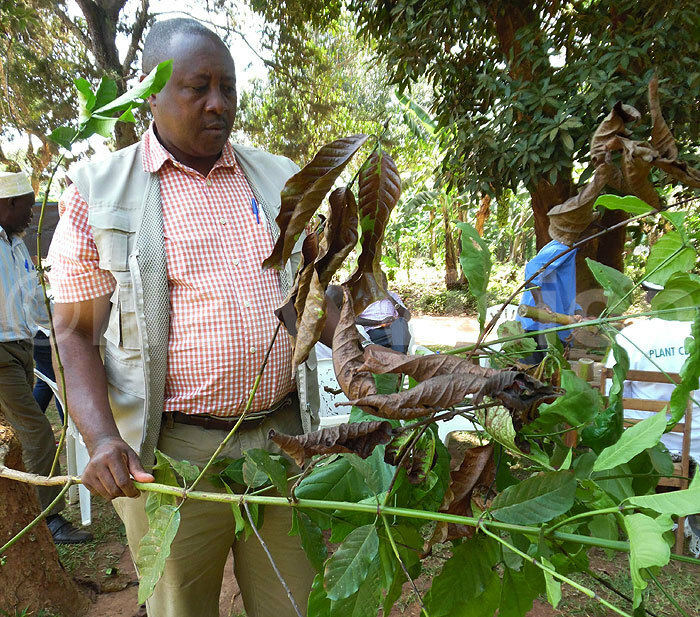Rampant coffee twig borer hits hard
The twig borer is a tiny beetle that bores holes mostly in tiny branches of the coffee tree where it can be hosted with a purpose of laying its eggs.
PIC: Acting commissioner at the Department of Crop Protection, Stephen Byantwale Tibeijuka (right) prunes a coffee tree that has been affected by coffee twig borer as a way to treat it. He is assisted by a farmer. Credit: Noah Jagwe)
The coffee twig borer has become so rampant in areas of Mukono, Masaka, Bukomansimbi, Kalungu as well as Kalungu and Luwero districts, and farmers are not at ease.
The outbreak has left many panicking over how to go about the situation.
Stephen Byantwale Tibeijuka, acting commissioner at the Department of Crop Protection, says the environmental factors contribute immensely to the spread of the pest in the coffee farms.
The pest spreads faster during the sunny season. This is so because during the rainy season a plant can fight the disease by itself and the effects can be minimal.
"The pest has been around for some time since 2005," says Tibeijuka. "We started receiving reports from areas of Mukono and Masaka."
The twig borer is a tiny beetle that bores holes mostly in tiny branches of the coffee tree and any other plant where it can be hosted with a purpose of laying its eggs. By doing this it disrupts the intake of the food for the plants.
Among factors that causeits widespread is the availability of alternative host plants like musizi, mango and avocado trees in the coffee plantations.
The stress of the soil also escalates the pest. When the soils no longer have enough nutrients for the plant, it makes them weak to withstand the diseases and pests.

Here, Tibeijuka diagnoses a coffee plant that has been attacked by coffee twig borer at a farm in Nywedde Malwa Kimenyede subcounty in Nakifuma. (Credit: Noah Jagwe)
Tibeijuka says that of all types, Robusta coffee is the most prone to the twig borer.
The pest has enormous effects on a plant, resulting in serious economic repercussions to the farmers.
In most cases, the borer drills holes which interfere with the nutrition flow of the plant that causes the drying of certain parts of the coffee tree. The pest disorganizes flow of food for the plant both from the leaves and the soil.
Suggested control measures
Systemic use of insecticide is useful to manage the growth of fungus on the tree. It's expensive though - a litre can go for about sh100,000.
Tibeijuka suggests cheaper alternatives, including pruning by cutting off the affected parts of the plant.
And this calls for immediate destruction of the parts of the plant that have been cut off by burning within the same place where they have been got.
If any attempt is made to move them over long distances or around the gardens, pathogens can be passed onto other plants, causing widespread.
Burning helps to destroy the eggs to avoid multiplication.